第二章 Struts2的工作機制及分析
概述
本章講述Struts2的工作原理。
讀者如果曾經學習過Struts1.x或者有過Struts1.x的開發經驗,那么千萬不要想當然地以為這一章可以跳過。實際上Struts1.x與Struts2并無我們想象的血緣關系。雖然Struts2的開發小組極力保留Struts1.x的習慣,但因為Struts2的核心設計完全改變,從思想到設計到工作流程,都有了很大的不同。
Struts2是Struts社區和WebWork社區的共同成果,我們甚至可以說,Struts2是WebWork的升級版,他采用的正是WebWork的核心,所以,Struts2并不是一個不成熟的產品,相反,構建在WebWork基礎之上的Struts2是一個運行穩定、性能優異、設計成熟的WEB框架。
本章主要對Struts的源代碼進行分析,因為Struts2與WebWork的關系如此密不可分,因此,讀者需要下載xwork的源代碼,訪問http://www.opensymphony.com/xwork/download.action即可自行下載。
下載的Struts2源代碼文件是一個名叫struts-2.1.0-src.zip的壓縮包,里面的目錄和文件非常多,讀者可以定位到struts-2.1.0-src"struts-2.0.10"src"core"src"main"java目錄下查看Struts2的源文件,如圖14所示。
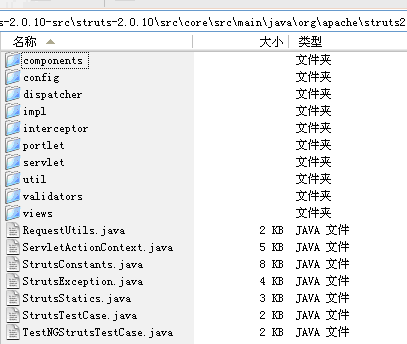
(圖14)
主要的包和類
Struts2框架的正常運行,除了占核心地位的xwork的支持以外,Struts2本身也提供了許多類,這些類被分門別類組織到不同的包中。從源代碼中發現,基本上每一個Struts2類都訪問了WebWork提供的功能,從而也可以看出Struts2與WebWork千絲萬縷的聯系。但無論如何,Struts2的核心功能比如將請求委托給哪個Action處理都是由xwork完成的,Struts2只是在WebWork的基礎上做了適當的簡化、加強和封裝,并少量保留Struts1.x中的習慣。
以下是對各包的簡要說明:
|
包名
|
說明
|
|
org.apache.struts2. components
|
該包封裝視圖組件,Struts2在視圖組件上有了很大加強,不僅增加了組件的屬性個數,更新增了幾個非常有用的組件,如updownselect、doubleselect、datetimepicker、token、tree等。
另外,Struts2可視化視圖組件開始支持主題(theme),缺省情況下,使用自帶的缺省主題,如果要自定義頁面效果,需要將組件的theme屬性設置為simple。
|
|
org.apache.struts2. config
|
該包定義與配置相關的接口和類。實際上,工程中的xml和properties文件的讀取和解析都是由WebWork完成的,Struts只做了少量的工作。
|
|
org.apache.struts2.dispatcher
|
Struts2的核心包,最重要的類都放在該包中。
|
|
org.apache.struts2.impl
|
該包只定義了3個類,他們是StrutsActionProxy、StrutsActionProxyFactory、StrutsObjectFactory,這三個類都是對xwork的擴展。
|
|
org.apache.struts2.interceptor
|
定義內置的截攔器。
|
|
org.apache.struts2.util
|
實用包。
|
|
org.apache.struts2.validators
|
只定義了一個類:DWRValidator。
|
|
org.apache.struts2.views
|
提供freemarker、jsp、velocity等不同類型的頁面呈現。
|
下表是對一些重要類的說明:
|
類名
|
說明
|
|
org.apache.struts2.dispatcher. Dispatcher
|
該類有兩個作用:
1、初始化
2、調用指定的Action的execute()方法。
|
|
org.apache.struts2.dispatcher. FilterDispatcher
|
這是一個過濾器。文檔中已明確說明,如果沒有經驗,配置時請將url-pattern的值設成/*。
該類有四個作用:
1、執行Action
2、清理ActionContext,避免內存泄漏
3、處理靜態內容(Serving static content)
4、為請求啟動xwork’s的截攔器鏈。
|
|
com.opensymphony.xwork2. ActionProxy
|
Action的代理接口。
|
|
com.opensymphony.xwork2. ctionProxyFactory
|
生產ActionProxy的工廠。
|
|
com.opensymphony.xwork2.ActionInvocation
|
負責調用Action和截攔器。
|
|
com.opensymphony.xwork2.config.providers.
XmlConfigurationProvider
|
負責Struts2的配置文件的解析。
|
Struts2的工作機制
3.1Struts2體系結構圖
Strut2的體系結構如圖15所示:
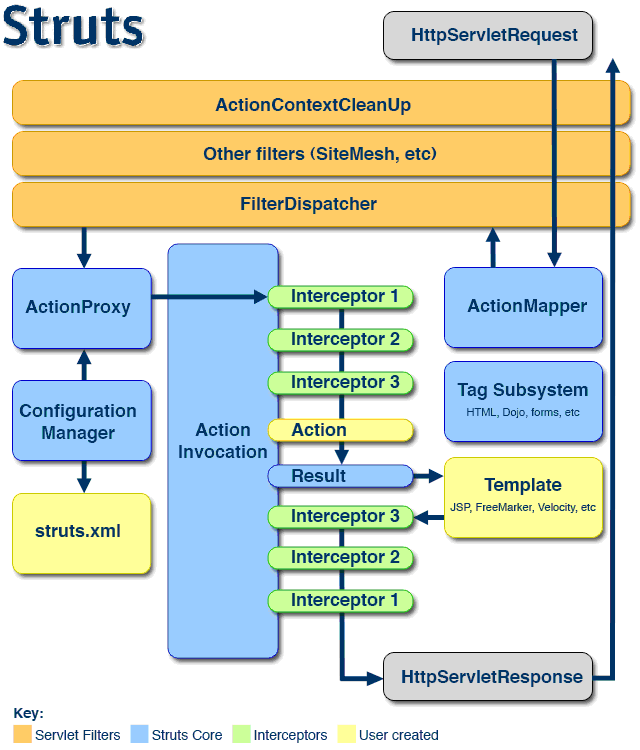
(圖15)
3.2Struts2的工作機制
從圖15可以看出,一個請求在Struts2框架中的處理大概分為以下幾個步驟:
1、客戶端初始化一個指向Servlet容器(例如Tomcat)的請求;
2、這個請求經過一系列的過濾器(Filter)(這些過濾器中有一個叫做ActionContextCleanUp的可選過濾器,這個過濾器對于Struts2和其他框架的集成很有幫助,例如:SiteMesh Plugin);
3、接著FilterDispatcher被調用,FilterDispatcher詢問ActionMapper來決定這個請求是否需要調用某個Action;
4、如果ActionMapper決定需要調用某個Action,FilterDispatcher把請求的處理交給ActionProxy;
5、ActionProxy通過Configuration Manager詢問框架的配置文件,找到需要調用的Action類;
6、ActionProxy創建一個ActionInvocation的實例。
7、ActionInvocation實例使用命名模式來調用,在調用Action的過程前后,涉及到相關攔截器(Intercepter)的調用。
8、一旦Action執行完畢,ActionInvocation負責根據struts.xml中的配置找到對應的返回結果。返回結果通常是(但不總是,也可能是另外的一個Action鏈)一個需要被表示的JSP或者FreeMarker的模版。在表示的過程中可以使用Struts2 框架中繼承的標簽。在這個過程中需要涉及到ActionMapper。
注:以上步驟參考至網上,具體網址已忘記。在此表示感謝!
3.3Struts2源代碼分析
和Struts1.x不同,Struts2的啟動是通過FilterDispatcher過濾器實現的。下面是該過濾器在web.xml文件中的配置:
代碼清單6:web.xml(截取)
<filter>
<filter-name>struts2</filter-name>
<filter-class>
org.apache.struts2.dispatcher.FilterDispatcher
</filter-class>
</filter>
<filter-mapping>
<filter-name>struts2</filter-name>
<url-pattern>/*</url-pattern>
</filter-mapping>
Struts2建議,在對Struts2的配置尚不熟悉的情況下,將url-pattern配置為/*,這樣該過濾器將截攔所有請求。
實際上,FilterDispatcher除了實現Filter接口以外,還實現了StrutsStatics接口,繼承代碼如下:
代碼清單7:FilterDispatcher結構
publicclass FilterDispatcher implements
StrutsStatics, Filter {
}
StrutsStatics并沒有定義業務方法,只定義了若干個常量。Struts2對常用的接口進行了重新封裝,比如HttpServletRequest、HttpServletResponse、HttpServletContext等。 以下是StrutsStatics的定義:
代碼清單8:StrutsStatics.java
publicinterface StrutsStatics {
/**
*ConstantfortheHTTPrequestobject.
*/
publicstaticfinal String HTTP_REQUEST = "com.opensymphony.xwork2.dispatcher.HttpServletRequest";
/**
*ConstantfortheHTTPresponseobject.
*/
publicstaticfinal String HTTP_RESPONSE = "com.opensymphony.xwork2.dispatcher.HttpServletResponse";
/**
*ConstantforanHTTPrequest
dispatcher}.
*/
publicstaticfinal String SERVLET_DISPATCHER = "com.opensymphony.xwork2.dispatcher.ServletDispatcher";
/**
*Constantfortheservlet
context}object.
*/
publicstaticfinal String SERVLET_CONTEXT = "com.opensymphony.xwork2.dispatcher.ServletContext";
/**
*ConstantfortheJSPpage
context}.
*/
publicstaticfinal String PAGE_CONTEXT = "com.opensymphony.xwork2.dispatcher.PageContext";
/**ConstantforthePortletContextobject*/
publicstaticfinal String STRUTS_PORTLET_CONTEXT = "struts.portlet.context";
}
容器啟動后,FilterDispatcher被實例化,調用init(FilterConfig filterConfig)方法。該方法創建Dispatcher類的對象,并且將FilterDispatcher配置的初始化參數傳到對象中(詳情請參考代碼清單10),并負責Action的執行。然后得到參數packages,值得注意的是,還有另外三個固定的包和該參數進行拼接,分別是org.apache.struts2.static、template、和org.apache.struts2.interceptor.debugging,中間用空格隔開,經過解析將包名變成路徑后存儲到一個名叫pathPrefixes的數組中,這些目錄中的文件會被自動搜尋。
代碼清單9:FilterDispatcher.init()方法
publicvoid init(FilterConfig filterConfig) throws ServletException {
this.filterConfig = filterConfig;
dispatcher = createDispatcher(filterConfig);
dispatcher.init();
String param = filterConfig.getInitParameter("packages");
String packages = "org.apache.struts2.static
template org.apache.struts2.interceptor.debugging";
if (param != null) {
packages = param + " " + packages;
}
this.pathPrefixes = parse(packages);
}
代碼清單10:FilterDispatcher.createDispatcher()方法
protected Dispatcher createDispatcher(FilterConfig filterConfig) {
Map<String,String> params = new
HashMap<String,String>();
for (Enumeration e =
filterConfig.getInitParameterNames(); e.hasMoreElements(); ) {
String name = (String) e.nextElement();
String value = filterConfig.getInitParameter(name);
params.put(name, value);
}
returnnew Dispatcher(filterConfig.getServletContext(),
params);
}
當用戶向Struts2發送請求時,FilterDispatcher的doFilter()方法自動調用,這個方法非常關鍵。首先,Struts2對請求對象進行重新包裝,此次包裝根據請求內容的類型不同,返回不同的對象,如果為multipart/form-data類型,則返回MultiPartRequestWrapper類型的對象,該對象服務于文件上傳,否則返回StrutsRequestWrapper類型的對象,MultiPartRequestWrapper是StrutsRequestWrapper的子類,而這兩個類都是HttpServletRequest接口的實現。包裝請求對象如代碼清單11所示:
代碼清單11:FilterDispatcher.prepareDispatcherAndWrapRequest()方法
protectedHttpServletRequest
prepareDispatcherAndWrapRequest(
HttpServletRequest
request,
HttpServletResponse
response) throws ServletException {
Dispatcher du = Dispatcher.getInstance();
if (du == null) {
Dispatcher.setInstance(dispatcher);
dispatcher.prepare(request, response);
} else {
dispatcher = du;
}
try {
request = dispatcher.wrapRequest(request, getServletContext());
} catch (IOException e) {
String message = "Could not
wrap servlet request with MultipartRequestWrapper!";
LOG.error(message, e);
thrownew ServletException(message, e);
}
return request;
}
request對象重新包裝后,通過ActionMapper的getMapping()方法得到請求的Action,Action的配置信息存儲在ActionMapping對象中,該語句如下:mapping = actionMapper.getMapping(request,
dispatcher.getConfigurationManager());。下面是ActionMapping接口的實現類DefaultActionMapper的getMapping()方法的源代碼:
代碼清單12:DefaultActionMapper.getMapping()方法
public ActionMapping getMapping(HttpServletRequest request,
ConfigurationManager configManager) {
ActionMapping mapping = new ActionMapping();
String uri = getUri(request);//得到請求路徑的URI,如:testAtcion.action或testAction!method
uri = dropExtension(uri);//刪除擴展名,默認擴展名為action,在代碼中的定義是List extensions = new ArrayList() {{
add("action");}};
if (uri == null) {
returnnull;
}
parseNameAndNamespace(uri, mapping, configManager);//從uri變量中解析出Action的name和namespace
handleSpecialParameters(request, mapping);//將請求參數中的重復項去掉
//如果Action的name沒有解析出來,直接返回
if (mapping.getName() == null) {
returnnull;
}
//下面處理形如testAction!method格式的請求路徑
if (allowDynamicMethodCalls) {
// handle
"name!method" convention.
String name = mapping.getName();
int exclamation = name.lastIndexOf("!");//!是Action名稱和方法名的分隔符
if (exclamation != -1) {
mapping.setName(name.substring(0, exclamation));//提取左邊為name
mapping.setMethod(name.substring(exclamation + 1));//提取右邊的method
}
}
return mapping;
}
該代碼的活動圖如下:
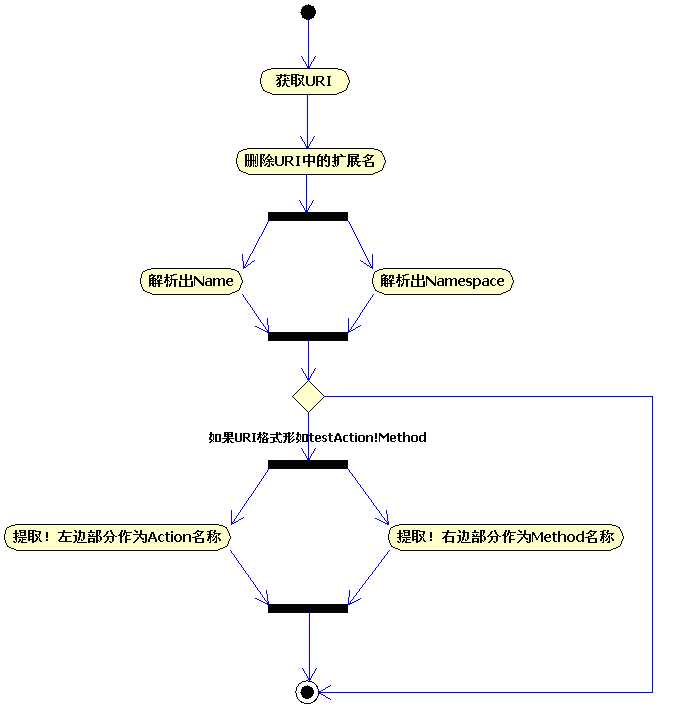
(圖16)
從代碼中看出,getMapping()方法返回ActionMapping類型的對象,該對象包含三個參數:Action的name、namespace和要調用的方法method。
如果getMapping()方法返回ActionMapping對象為null,則FilterDispatcher認為用戶請求不是Action,自然另當別論,FilterDispatcher會做一件非常有意思的事:如果請求以/struts開頭,會自動查找在web.xml文件中配置的packages初始化參數,就像下面這樣(注意粗斜體部分):
代碼清單13:web.xml(部分)
<filter>
<filter-name>struts2</filter-name>
<filter-class>
org.apache.struts2.dispatcher.FilterDispatcher
</filter-class>
<init-param>
<param-name>packages</param-name>
<param-value>com.lizanhong.action</param-value>
</init-param>
</filter>
FilterDispatcher會將com.lizanhong.action包下的文件當作靜態資源處理,即直接在頁面上顯示文件內容,不過會忽略擴展名為class的文件。比如在com.lizanhong.action包下有一個aaa.txt的文本文件,其內容為“中華人民共和國”,訪問http://localhost:8081/Struts2Demo/struts/aaa.txt時會有如圖17的輸出:

(圖17)
查找靜態資源的源代碼如清單14:
代碼清單14:FilterDispatcher.findStaticResource()方法
protectedvoid findStaticResource(String name,
HttpServletRequest request, HttpServletResponse response) throws IOException {
if (!name.endsWith(".class")) {//忽略class文件
//遍歷packages參數
for (String pathPrefix : pathPrefixes) {
InputStream is =
findInputStream(name, pathPrefix);//讀取請求文件流
if (is != null) {
……(省略部分代碼)
// set the
content-type header
String contentType =
getContentType(name);//讀取內容類型
if
(contentType != null) {
response.setContentType(contentType);//重新設置內容類型
}
……(省略部分代碼)
try {
//將讀取到的文件流以每次復制4096個字節的方式循環輸出
copy(is,
response.getOutputStream());
} finally {
is.close();
}
return;
}
}
}
}
如果用戶請求的資源不是以/struts開頭——可能是.jsp文件,也可能是.html文件,則通過過濾器鏈繼續往下傳送,直到到達請求的資源為止。
如果getMapping()方法返回有效的ActionMapping對象,則被認為正在請求某個Action,將調用Dispatcher.serviceAction(request, response,
servletContext, mapping)方法,該方法是處理Action的關鍵所在。上述過程的源代碼如清單15所示。
代碼清單15:FilterDispatcher.doFilter()方法
publicvoid doFilter(ServletRequest req, ServletResponse
res, FilterChain chain) throws IOException, ServletException {
HttpServletRequest request = (HttpServletRequest) req;
HttpServletResponse response = (HttpServletResponse) res;
ServletContext servletContext = getServletContext();
String timerKey = "FilterDispatcher_doFilter:
";
try {
UtilTimerStack.push(timerKey);
request = prepareDispatcherAndWrapRequest(request, response);//重新包裝request
ActionMapping mapping;
try {
mapping =
actionMapper.getMapping(request, dispatcher.getConfigurationManager());//得到存儲Action信息的ActionMapping對象
} catch (Exception ex) {
……(省略部分代碼)
return;
}
if (mapping == null) {//如果mapping為null,則認為不是請求Action資源
String resourcePath =
RequestUtils.getServletPath(request);
if ("".equals(resourcePath) && null != request.getPathInfo()) {
resourcePath =
request.getPathInfo();
}
//如果請求的資源以/struts開頭,則當作靜態資源處理
if (serveStatic && resourcePath.startsWith("/struts")) {
String name =
resourcePath.substring("/struts".length());
findStaticResource(name,
request, response);
} else {
//否則,過濾器鏈繼續往下傳遞
chain.doFilter(request,
response);
}
// The framework did its job here
return;
}
//如果請求的資源是Action,則調用serviceAction方法。
dispatcher.serviceAction(request, response, servletContext, mapping);
} finally {
try {
ActionContextCleanUp.cleanUp(req);
} finally {
UtilTimerStack.pop(timerKey);
}
}
}
這段代碼的活動圖如圖18所示:
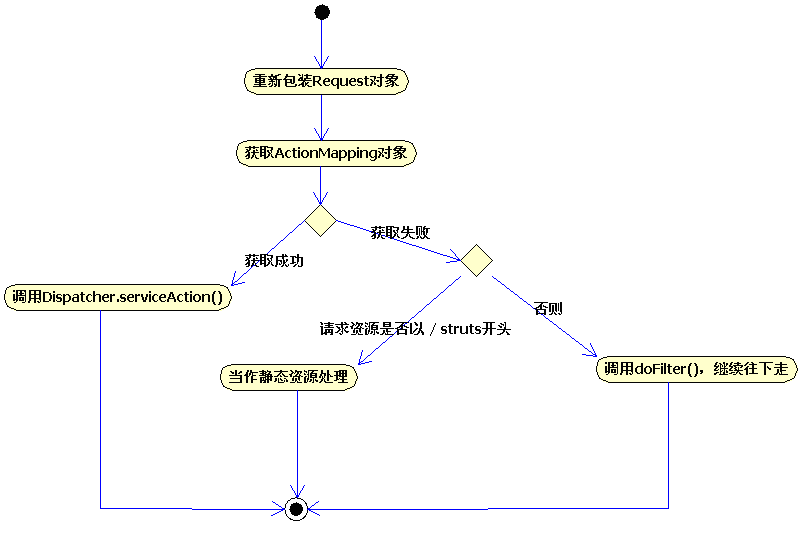
(圖18)
在Dispatcher.serviceAction()方法中,先加載Struts2的配置文件,如果沒有人為配置,則默認加載struts-default.xml、struts-plugin.xml和struts.xml,并且將配置信息保存在形如com.opensymphony.xwork2.config.entities.XxxxConfig的類中。
類com.opensymphony.xwork2.config.providers.XmlConfigurationProvider負責配置文件的讀取和解析, addAction()方法負責讀取<action>標簽,并將數據保存在ActionConfig中;addResultTypes()方法負責將<result-type>標簽轉化為ResultTypeConfig對象;loadInterceptors()方法負責將<interceptor>標簽轉化為InterceptorConfi對象;loadInterceptorStack()方法負責將<interceptor-ref>標簽轉化為InterceptorStackConfig對象;loadInterceptorStacks()方法負責將<interceptor-stack>標簽轉化成InterceptorStackConfig對象。而上面的方法最終會被addPackage()方法調用,將所讀取到的數據匯集到PackageConfig對象中,細節請參考代碼清單16。
代碼清單16:XmlConfigurationProvider.addPackage()方法
protected PackageConfig addPackage(Element packageElement) throws ConfigurationException {
PackageConfig newPackage = buildPackageContext(packageElement);
if (newPackage.isNeedsRefresh()) {
return newPackage;
}
if (LOG.isDebugEnabled()) {
LOG.debug("Loaded
" + newPackage);
}
// add result types (and
default result) to this package
addResultTypes(newPackage, packageElement);
// load the interceptors and
interceptor stacks for this package
loadInterceptors(newPackage, packageElement);
// load the default
interceptor reference for this package
loadDefaultInterceptorRef(newPackage, packageElement);
// load the default class ref
for this package
loadDefaultClassRef(newPackage, packageElement);
// load the global result
list for this package
loadGlobalResults(newPackage, packageElement);
// load the global exception
handler list for this package
loadGlobalExceptionMappings(newPackage, packageElement);
// get actions
NodeList actionList = packageElement.getElementsByTagName("action");
for (int i = 0; i
< actionList.getLength(); i++) {
Element actionElement = (Element) actionList.item(i);
addAction(actionElement, newPackage);
}
// load the default action
reference for this package
loadDefaultActionRef(newPackage, packageElement);
configuration.addPackageConfig(newPackage.getName(),
newPackage);
return newPackage;
}
活動圖如圖19所示:
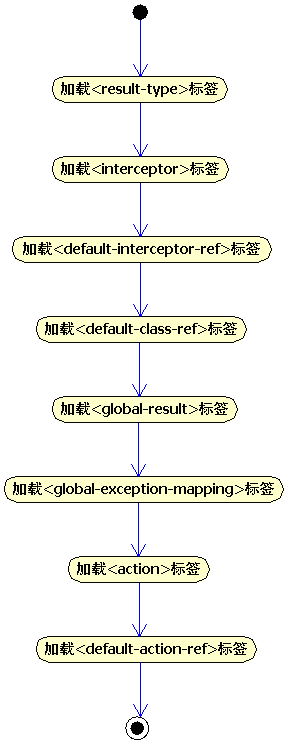
(圖19)
配置信息加載完成后,創建一個Action的代理對象——ActionProxy引用,實際上對Action的調用正是通過ActionProxy實現的,而ActionProxy又由ActionProxyFactory創建,ActionProxyFactory是創建ActionProxy的工廠。
注:ActionProxy和ActionProxyFactory都是接口,他們的默認實現類分別是DefaultActionProxy和DefaultActionProxyFactory,位于com.opensymphony.xwork2包下。
在這里,我們絕對有必要介紹一下com.opensymphony.xwork2.DefaultActionInvocation類,該類是對ActionInvocation接口的默認實現,負責Action和截攔器的執行。
在DefaultActionInvocation類中,定義了invoke()方法,該方法實現了截攔器的遞歸調用和執行Action的execute()方法。其中,遞歸調用截攔器的代碼如清單17所示:
代碼清單17:調用截攔器,DefaultActionInvocation.invoke()方法的部分代碼
if (interceptors.hasNext()) {
//從截攔器集合中取出當前的截攔器
final
InterceptorMapping interceptor = (InterceptorMapping) interceptors.next();
UtilTimerStack.profile("interceptor: "+interceptor.getName(),
new
UtilTimerStack.ProfilingBlock<String>() {
public String doProfiling() throws Exception {
//執行截攔器(Interceptor)接口中定義的intercept方法
resultCode
= interceptor.getInterceptor().intercept(DefaultActionInvocation.this);
returnnull;
}
});
}
從代碼中似乎看不到截攔器的遞歸調用,其實是否遞歸完全取決于程序員對程序的控制,先來看一下Interceptor接口的定義:
代碼清單18:Interceptor.java
publicinterface Interceptor extends
Serializable {
void destroy();
void init();
String intercept(ActionInvocation invocation) throws Exception;
}
所有的截攔器必須實現intercept方法,而該方法的參數恰恰又是ActionInvocation,所以,如果在intercept方法中調用invocation.invoke(),代碼清單17會再次執行,從Action的Intercepor列表中找到下一個截攔器,依此遞歸。下面是一個自定義截攔器示例:
代碼清單19:CustomIntercepter.java
publicclass CustomIntercepter extends AbstractInterceptor {
@Override
public String intercept(ActionInvocation actionInvocation) throws Exception
{
actionInvocation.invoke();
return"李贊紅";
}
}
截攔器的調用活動圖如圖20所示:
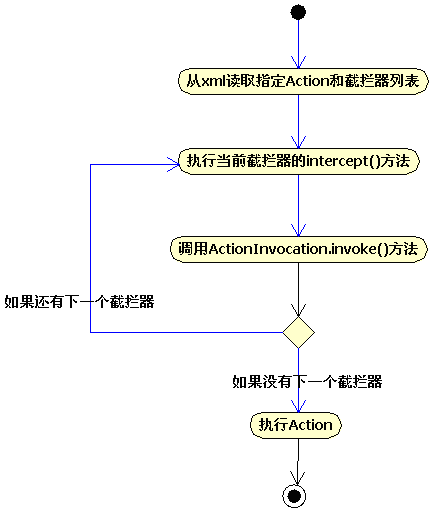
(圖20)
如果截攔器全部執行完畢,則調用invokeActionOnly()方法執行Action,invokeActionOnly()方法基本沒做什么工作,只調用了invokeAction()方法。
為了執行Action,必須先創建該對象,該工作在DefaultActionInvocation的構造方法中調用init()方法早早完成。調用過程是:DefaultActionInvocation()->init()->createAction()。創建Action的代碼如下:
代碼清單20:DefaultActionInvocation.createAction()方法
protectedvoid createAction(Map contextMap) {
try {
action =
objectFactory.buildAction(proxy.getActionName(), proxy.getNamespace(),
proxy.getConfig(), contextMap);
} catch (InstantiationException e) {
……異常代碼省略
}
}
Action創建好后,輪到invokeAction()大顯身手了,該方法比較長,但關鍵語句實在很少,用心點看不會很難。
代碼清單20:DefaultActionInvocation.invokeAction()方法
protected String invokeAction(Object action,
ActionConfig actionConfig) throws Exception {
//獲取Action中定義的execute()方法名稱,實際上該方法是可以隨便定義的
String methodName = proxy.getMethod();
String timerKey = "invokeAction:
"+proxy.getActionName();
try {
UtilTimerStack.push(timerKey);
Method method;
try {
//將方法名轉化成Method對象
method = getAction().getClass().getMethod(methodName,
new Class[0]);
} catch (NoSuchMethodException e) {
// hmm -- OK, try doXxx instead
try {
//如果Method出錯,則嘗試在方法名前加do,再轉成Method對象
String altMethodName = "do" + methodName.substring(0, 1).toUpperCase() +
methodName.substring(1);
method =
getAction().getClass().getMethod(altMethodName, new Class[0]);
} catch
(NoSuchMethodException e1) {
// throw the original one
throw e;
}
}
//執行方法
Object methodResult = method.invoke(action, new Object[0]);
//處理跳轉
if (methodResult instanceof Result) {
this.result =
(Result) methodResult;
returnnull;
} else {
return (String)
methodResult;
}
} catch (NoSuchMethodException e) {
……省略異常代碼
} finally {
UtilTimerStack.pop(timerKey);
}
}
剛才使用了一段插述,我們繼續回到ActionProxy類。
我們說Action的調用是通過ActionProxy實現的,其實就是調用了ActionProxy.execute()方法,而該方法又調用了ActionInvocation.invoke()方法。歸根到底,最后調用的是DefaultActionInvocation.invokeAction()方法。
以下是調用關系圖:

其中:
Ø
ActionProxy:管理Action的生命周期,它是設置和執行Action的起始點。
Ø
ActionInvocation:在ActionProxy層之下,它表示了Action的執行狀態。它持有Action實例和所有的Interceptor
以下是serviceAction()方法的定義:
代碼清單21:Dispatcher.serviceAction()方法
publicvoid serviceAction(HttpServletRequest request,
HttpServletResponse response, ServletContext context,
ActionMapping
mapping) throws ServletException {
Map<String, Object> extraContext = createContextMap(request,
response, mapping, context);
// If there was a previous
value stack, then create a new copy and pass it in to be used by the new Action
ValueStack stack = (ValueStack) request.getAttribute(ServletActionContext.STRUTS_VALUESTACK_KEY);
if (stack != null) {
extraContext.put(ActionContext.VALUE_STACK,
ValueStackFactory.getFactory().createValueStack(stack));
}
String timerKey = "Handling
request from Dispatcher";
try {
UtilTimerStack.push(timerKey);
String namespace = mapping.getNamespace();
String name = mapping.getName();
String method = mapping.getMethod();
Configuration config = configurationManager.getConfiguration();
ActionProxy proxy =
config.getContainer().getInstance(ActionProxyFactory.class).createActionProxy(
namespace, name,
extraContext, true, false);
proxy.setMethod(method);
request.setAttribute(ServletActionContext.STRUTS_VALUESTACK_KEY,
proxy.getInvocation().getStack());
// if the ActionMapping says
to go straight to a result, do it!
if (mapping.getResult() != null) {
Result result =
mapping.getResult();
result.execute(proxy.getInvocation());
} else {
proxy.execute();
}
// If there was a previous
value stack then set it back onto the request
if (stack != null) {
request.setAttribute(ServletActionContext.STRUTS_VALUESTACK_KEY, stack);
}
} catch (ConfigurationException e) {
LOG.error("Could not
find action or result", e);
sendError(request, response, context, HttpServletResponse.SC_NOT_FOUND,
e);
} catch (Exception e) {
thrownew ServletException(e);
} finally {
UtilTimerStack.pop(timerKey);
}
}
最后,通過Result完成頁面的跳轉。
3.4 本小節總結
總體來講,Struts2的工作機制比Struts1.x要復雜很多,但我們不得不佩服Struts和WebWork開發小組的功底,代碼如此優雅,甚至能夠感受看到兩個開發小組心神相通的默契。兩個字:佩服。
以下是Struts2運行時調用方法的順序圖:
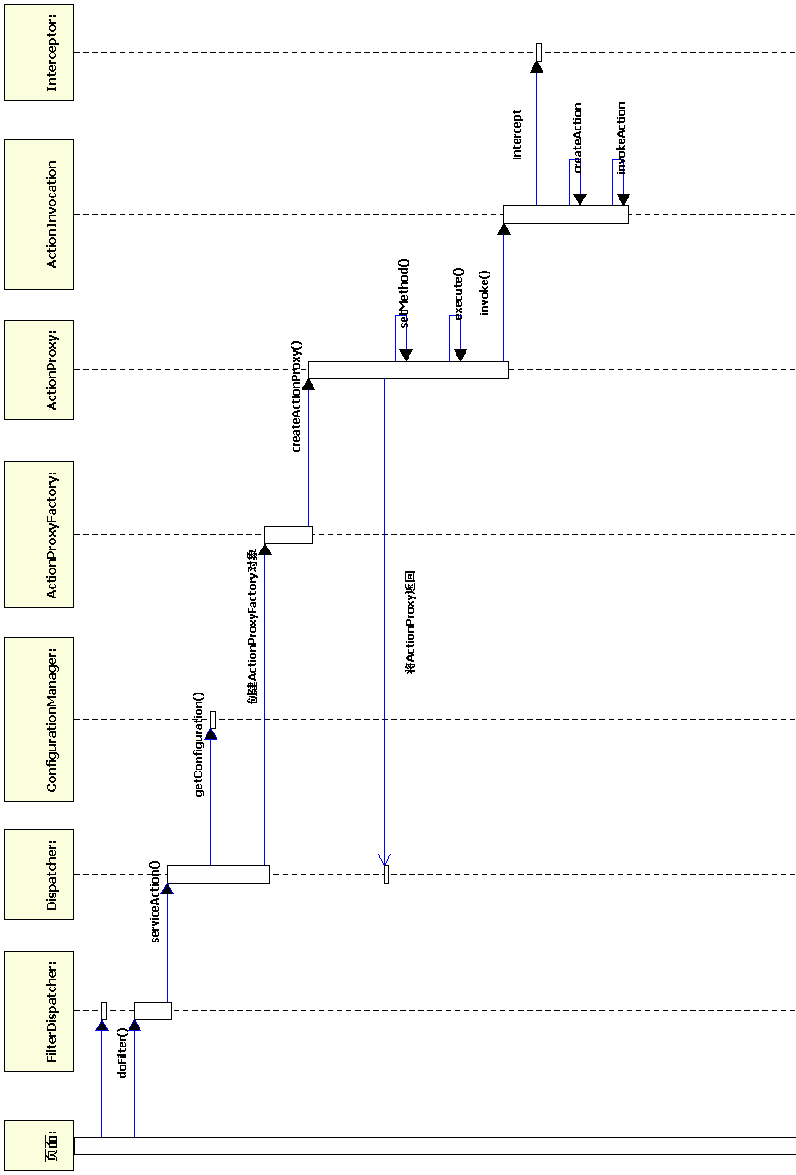
(圖21)
四、
總結
閱讀源代碼是一件非常辛苦的事,對讀者本身的要求也很高,一方面要有扎實的功底,另一方面要有超強的耐力和恒心。本章目的就是希望能幫助讀者理清一條思路,在必要的地方作出簡單的解釋,達到事半功倍的效果。
當然,筆者不可能為讀者解釋所有類,這也不是我的初衷。Struts2+xwork一共有700余類,除了為讀者做到現在的這些,已無法再做更多的事情。讀者可以到Struts官方網站下載幫助文檔,慢慢閱讀和理解,相信會受益頗豐。
本章并不適合java語言初學者或者對java博大精深的思想理解不深的讀者閱讀,這其中涉及到太多的術語和類的使用,特別不要去鉆牛角尖,容易使自信心受損。基本搞清楚Struts2的使用之后,再回過頭來閱讀本章,對一些知識點和思想也許會有更深的體會。
如果讀者的java功底比較渾厚,而且對Struts2充滿興趣,但又沒太多時間研究,不妨仔細閱讀本章,再對照Struts的源代碼,希望對您有所幫助。